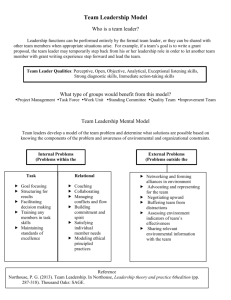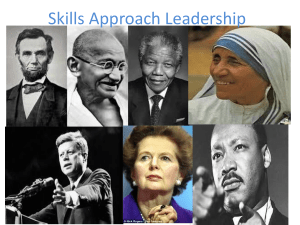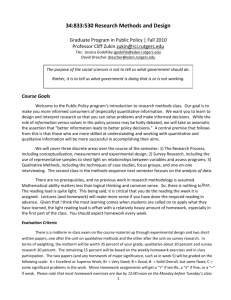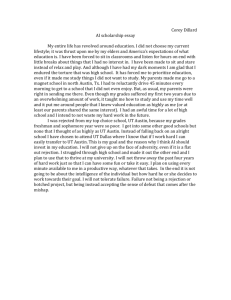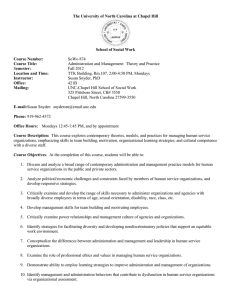Document
advertisement
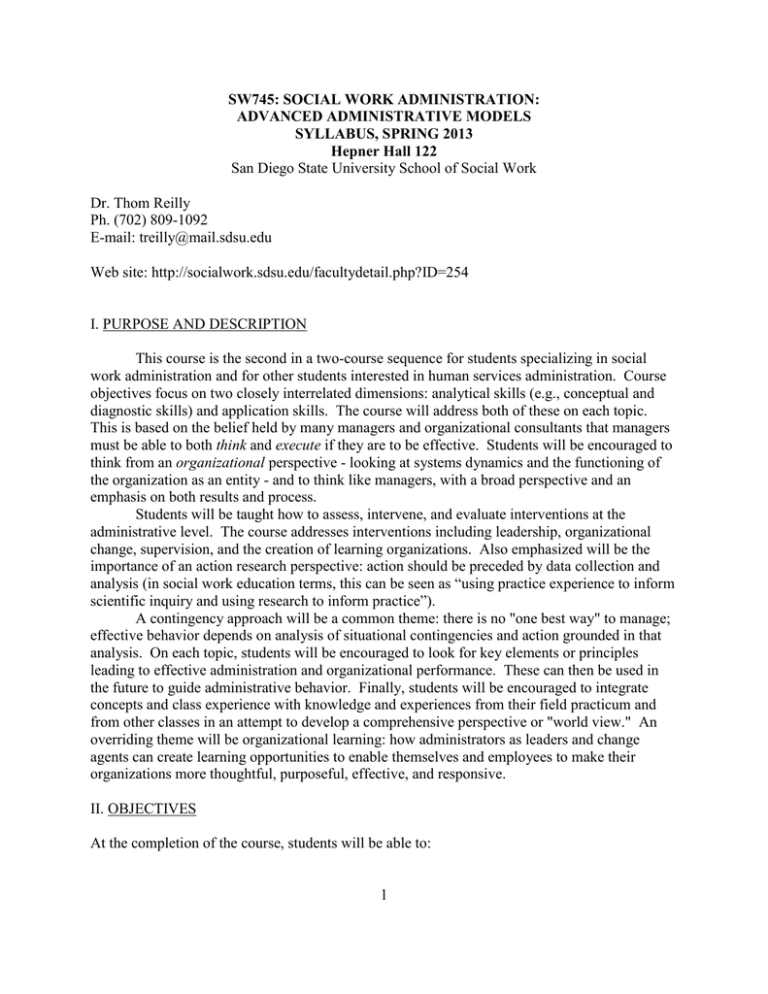
SW745: SOCIAL WORK ADMINISTRATION: ADVANCED ADMINISTRATIVE MODELS SYLLABUS, SPRING 2013 Hepner Hall 122 San Diego State University School of Social Work Dr. Thom Reilly Ph. (702) 809-1092 E-mail: treilly@mail.sdsu.edu Web site: http://socialwork.sdsu.edu/facultydetail.php?ID=254 I. PURPOSE AND DESCRIPTION This course is the second in a two-course sequence for students specializing in social work administration and for other students interested in human services administration. Course objectives focus on two closely interrelated dimensions: analytical skills (e.g., conceptual and diagnostic skills) and application skills. The course will address both of these on each topic. This is based on the belief held by many managers and organizational consultants that managers must be able to both think and execute if they are to be effective. Students will be encouraged to think from an organizational perspective - looking at systems dynamics and the functioning of the organization as an entity - and to think like managers, with a broad perspective and an emphasis on both results and process. Students will be taught how to assess, intervene, and evaluate interventions at the administrative level. The course addresses interventions including leadership, organizational change, supervision, and the creation of learning organizations. Also emphasized will be the importance of an action research perspective: action should be preceded by data collection and analysis (in social work education terms, this can be seen as “using practice experience to inform scientific inquiry and using research to inform practice”). A contingency approach will be a common theme: there is no "one best way" to manage; effective behavior depends on analysis of situational contingencies and action grounded in that analysis. On each topic, students will be encouraged to look for key elements or principles leading to effective administration and organizational performance. These can then be used in the future to guide administrative behavior. Finally, students will be encouraged to integrate concepts and class experience with knowledge and experiences from their field practicum and from other classes in an attempt to develop a comprehensive perspective or "world view." An overriding theme will be organizational learning: how administrators as leaders and change agents can create learning opportunities to enable themselves and employees to make their organizations more thoughtful, purposeful, effective, and responsive. II. OBJECTIVES At the completion of the course, students will be able to: 1 Knowledge: 1. appraise organizational issues related to discrimination and oppression and suggest ways to counteract them 2. critique an organization’s cultural competence and develop strategies for improvement 3. describe and critique key principles of leadership effectiveness 4. describe key principles of supervision in human service organizations 5. describe key principles for creating and maintaining an organizational learning culture Skills: 6. articulate the use of leadership competencies for use in an organizational task group or program 7. identify an organization's problems amenable to organizational change and develop a viable change plan 8. use an evidence-based practice process to critique the empirical literature on leadership 9. critically assess one’s leadership styles and skills and use this to develop one’s own approach to leadership Values and Ethics: 10. articulate key ethical and value issues affecting human service organizations and suggest ways to manage them III. OUTCOMES After completing this course, the student will be able to: 1. use evidence-based practice processes to appraise the literatures in leadership and organizational change to help develop an appropriate skill set for an agency administrator 2. articulate competencies necessary to lead a program, unit, or organizational task group 3. create appropriate and effective strategies to improve operations or processes in an organization 4. use principles of diversity to help create a more culturally competent organization 5. interpret the Social Work Code of Ethics and related humanistic values as they apply to administrative practice IV. TEXTBOOKS AND READINGS Northouse, P. (2012). Introduction to Leadership: Concepts and Practice. Thousand Oaks, CA: Sage Publications. 2 Proehl, R. (2001). Organizational Change in the Human Services. Thousand Oaks, CA: Sage Publications. Austin, M., Brody, R., Packard, T. (Eds.) (2008). Managing and Leading Human Service Organizations: A Casebook. Thousand Oaks, CA: Sage Publications. Reprints and additional course materials on Blackboard. V. COURSE ASSIGNMENTS A. Leadership Literature Critique: Each student will write a paper consisting of descriptions and critiques of selected articles from the leadership literature. Details are included below. The due date is indicated on the session schedule below. The paper will be worth 30% of the course grade. B. Organizational Change Plan: Each student will write a paper consisting of a change plan based on problems or needs identified in the management audit in SW 740. Students who did not take SW 740 should contact the instructor to discuss using a different change opportunity. Use the format below. The due date is indicated on the session schedule below. The paper will be worth 30% of the course grade. A model of a change plan paper will be made available. C. 360-degree feedback: Each student will write a paper based on designated instruments and feedback to assess her or his leadership style. Follow the instructions in a later section below. The due date is indicated on the session schedule below. The paper will be worth 30% of the course grade. Two models of 360-degree feedback papers are at Blackboard. Papers will be graded on their responsiveness to the assignment as covered in the syllabus and attachments. Each paper should be typed and double-spaced, with numbered pages. Staple the upper left corner or use a metal clip; do not include a cover or binding. Use 1" margins and 12-point type font, and APA format. Additional grading factors are: Content: accurate, comprehensive, documented appropriately Persuasiveness: points are adequately supported Appropriateness & feasibility: ideas are viable Creativity: ideas and connections among themes are creative and insightful Organization, completeness, coherence & clarity: different elements are appropriately sequenced and connected; thoughts are stated specifically Sentence structure, grammar, & spelling: sentences convey meaning clearly & grammatically, no fragments or run-on sentences; writing is free of errors Style: interesting, imaginative use of language; tone suitable to purpose & audience Written feedback will not be provided on deficiencies in style, grammar, etc. If you are weak in any of these areas, consult William Strunk & E. B. White's The Elements of Style, an editor, or a similar source. 3 Any paper may be submitted early (ideally 2 weeks before the due date) for preliminary feedback and rewriting as the instructor’s time allows. Late papers will have the grade lowered one step (e.g., from B to C) for each week they are late. Work incomplete at the end of the semester will receive an F unless prior arrangements are made. NOTE: If you want the final paper returned, provide a stamped, self-addressed envelope at the final session. D. Participation: Students will be expected to be able to discuss and critique key points of each required assigned reading and suggest applications to practice to demonstrate mastery of the material. CASE DISCUSSIONS: Case discussions are a valuable learning opportunity and will be used regularly in this class. To prepare for case discussions, students should before class read the case and have notes to answer each case question. Student participation in case discussions which reflects preparation, insight regarding case issues and underlying implications, and the use of course concepts and principles in assessment and responses will be part of the class participation grade. Ratings of class participation will also be based upon students' demonstrations of knowledge and understanding of readings as reflected in comments and questions asked, comments which show connections among different concepts and issues, comments connecting the classroom to actual practice (e.g., examples at internships and jobs), listening and non-judgmental attitudes, responsible use of air time, and group process and nonverbal behaviors. All of these behaviors are relevant in an administrative setting and reflect administrative skills. Attendance at all of each session is expected, as it should contribute to the student’s accomplishment of course objectives. Attendance will be part of the participation grade to the extent that absent students will, of course, not have an opportunity to participate. Not following agreed-upon class norms will impact the participation grade. The following overall standards will be used: A: Consistent, active involvement without dominating; high level of knowledge and insight; comments are on topic; efficient use of air time; interacts with, refers to comments of, and/or draws out other students B: Regular involvement; good level of knowledge and insight; comments are on topic C: Occasional comments; usually on topic D: Rare comments, usually on topic F: No participation, or participation always off topic Additionally, student sharing in class regarding selected readings from their leadership article analysis paper may be included in the participation grade. Details will be covered in class. Participation will be worth 10% of the course grade. E. Overall Grading Criteria: Grades will be based on criteria and standards of the Graduate Bulletin and the School of Social Work Grading Policy documented in the Graduate Student Handbook. 4 As can be seen from the definitions of letter grades, summarized below, “A” grades are for truly outstanding work and are likely to be rare. A: work that not only demonstrates excellent mastery of content, but also shows that the student has a) undertaken complex tasks, b) applied critical thinking skills to the assignment, and/or c) demonstrated creativity in her or his approach to the assignment. The degree to which the student demonstrates these skills determines whether he/she receives an A or an A-. B+: work that is judged to be very good. This grade denotes that a student has demonstrated a more-than-satisfactory understanding of the material being tested, and has exceeded expectations in the assignment. B: work that meets the basic requirements of the assignment. It denotes that the student has done satisfactory work on the assignment and meets the expectations of the course. B-: performance was less than satisfactory on an assignment, reflecting only moderate grasp of content and is below expectations. C: reflects a minimal grasp of the assignments, poor organization of ideas and/or several significant areas requiring improvement. C- to F: a failure to meet minimum standards, reflecting serious deficiencies in a student’s performance on the assignment. VI. COURSE TOPICS AND READINGS Students are encouraged to bring to class copies of all readings required for a session to refer to during discussions and activities as needed. NOTE: BB = the document is at the course Blackboard site. NOTE: For all Northouse readings, complete the questionnaire indicated at the beginning of the chapter. SESSION DATE 1 1-23 TOPICS AND READINGS Overview, plans for the course Johnson, M. & Austin. M. (2006). Evidence-based practice in the social services: Implications for organizational change, Administration in Social Work, 30(3), 75-104. BB NOTE: Before next class, fill out and score the Personal Style Inventory (BB) OR go to http://similarminds.com/jung_word_pair.html and fill out the questionnaire. Either of these will give you a 4-letter profile. (If there are ties, note that in your profile) Email your profile to the professor by January 29. 2 1-30 Leadership overview, traits, leading across boundaries Northouse, Chs. 1, 2 5 Leadership and Other Key Factors Related to Organizational Performance BB Kettl (2000). The Transformation of Governance BB Frahm & Martin (2009). From Government to Governance BB Morse (2010) Art of Leading Across Boundaries BB Power Point (Leading) BB 3 2-6 Leadership: Styles, behaviors, models Northouse, CHs. 3, 4 Austin, Brody, & Packard: Case 4.3: To Talk or Not to Talk Leadership and Performance in Human Service Organizations, pp. 146-154 BB Portillo & DeHart-Davis (2009) Gender and Organizational Abidance BB 4 2-13 Leadership: Skills, models Northouse, Chs. 5, 6, 7 Austin, Brody, & Packard: Case 4.6: Executive Leadership Kouzes, J. & Posner, B. (2001). Exemplary Leaders, Executive Excellence; June 2001, 18(6), pp. 5-6, Available on line, SDSU Library 5 2-20 Leadership: Obstacles, Development, 360-degree feedback Northouse, Ch. 9 Austin, Brody, & Packard: Case 8.4: Jefferson Hospital. NOTE: Use the Strategic Issues debriefing questions on p. 22 of Austin, Brody, and Packard for this case. Leadership Style Indicator BB LSI Adjectives BB Leadership Style Indicator Description Summary BB LSI Feedback: Getting the Most out of Your LSI Feedback, Positive leadership Style Characteristics BB Personal Style Inventory BB National Network For Social Work Managers Leader and Manager Competency Model BB Personal Development Plan BB 6 2-27 Organizational Change: Overview Proehl, Chs. 2, 5, 6 Essential Elements for Managing Complex Change BB Austin, Brody, & Packard: Case 4.7: Marian Health Center. NOTE: Use the Strategic Issues debriefing questions on p. 22 of Austin, Brody, and Packard for this case. 7 3-5 Organizational Change: Change model, initiation 6 Proehl, Chs. 7-9 LEADERSHIP LITERATURE CRITIQUE PAPER DUE 8 3-12 Organizational Change: Implementation, cutback management Proehl, Chs. 10, 11, 13; Epilogue Austin, Brody, & Packard: Case 4.8: Mosaic County Welfare Department. NOTE: Use the Strategic Issues debriefing questions on p. 22 of Austin, Brody, and Packard for this case. Change Technologies BB Organization Development BB Employee Attitude Surveys as an Action Research Tool BB Problem Solving Groups for Organizational Change BB Team Building BB Role Clarification BB Transition Management BB 9 3-19 Organizational Change: Implementation, continued, challenges Proehl, Ch. 3 Woodward (2009) Engaging Frontline Workers in Times of Organizational Change jwright@mesharpe.comBB Cutback Management Strategies: Experiences in Nine County Human Service Agencies BB Change Management BB Cause and Effect Diagram BB Flowchart Showing Process of Psychological Testing BB Spring Break: March 26 - April 1 10 4-2 No Class: Comprehensive Exams 11 4-9 Cultural competence, diversity issues in the workplace Austin & Hopkins, Ch. 5 Northouse, Ch. 8 Terry Cross (1989) Towards a Culturally Competent System Of Care BB Austin, Brody, & Packard: Case 4.2: Mediating Differences in Gender and Work Style Managing for Diversity and Empowerment in Human Service Agencies BB Managing Diversity BB Conceptual Frameworks/Models, Guiding Values and Principles available at http://www11.georgetown.edu/research/gucchd/nccc/foundations/frameworks.html A Guide to Planning and Implementing Cultural Competence Organizational Self 7 Assessment available at http://gucchd.georgetown.edu/nccc/documents/ncccorgselfassess.pdf ORGANIZATIONAL CHANGE PLAN PAPER DUE 12 4-16 Supervision 1: Fundamentals Austin & Hopkins, Chs. 4, Effective Interpersonal and Critical Thinking BB Brody Ch 10 Supervising Staff BB Austin, Brody, & Packard: Case 7.12: Supervising Five Case managers: Read the entire case, and then select one segment for analysis. Answer the discussion question for that segment prior to class for discussion in class. 13 4-23 Supervision 2: Advanced Austin & Hopkins, Ch. 15 Creating A Culture That Supports The Development of Staff BB Austin, Brody, & Packard: Case 7.13: Supervisory Leadership: Read the entire case, and then select one segment for analysis. Answer the discussion question for that segment prior to class for discussion in class. 14 4-30 Creating a learning culture Austin & Hopkins, Chs. 2,& 16 Learning Organizations Moynihan & Landuyt (2009) How Do Public Organizations Learn? BB 15 5-7 Values & ethics, synthesis Northouse, Ch. 10 The Essence of Ethical Leadership BB Austin, Brody, & Packard: Case 4.12: What? Me Worry? 5-14: No class; the 360 DEGREE FEEDBACK PAPER IS DUE 8 LEADERSHIP LITERATURE CRITIQUE Each student will select four articles on leadership from the human services, public administration, or general management literature and write a paper summarizing and critiquing each article, using the questions below. The paper should be 12-14 pages in length. Try to select articles which have a clearly stated evidence base, and ideally ones with a high level of evidence. Suggested sources include the journals Leadership Quarterly, Nonprofit Management and Leadership, Administration in Social Work, Leadership & Organization Development Journal, Public Administration Review, Review of Public Personnel Administration and Journal of Applied Psychology. In the opening section, briefly describe the search process you used to find relevant articles: What were your interest areas? What did you want to focus on? What data bases or search methods did you use? How successful were you at identifying high quality (e.g., evidencebased or at least authority-based) and relevant articles? Then, include the following information for each article: Article name, author, source, year, volume, and pages. The theoretical framework or model used, hypotheses, and research questions, if any. Research or data collection methods, data sources, analysis. A summary of key findings or messages. A critique of the strength of the article’s theoretical and empirical aspects, including its level in the hierarchy of evidence, quality of the source, and research or authority base. You may use Austin and Claasen (assigned reading; figures 1 and/or 3), Cournoyer (2004), or McNeese and Thyer (2004) for this assessment. Suggestions for practice applications of the findings or assertions in the article. Any adaptations in order to apply in human service organizations. In a final section, discuss themes across the articles in terms of their evidence base, theoretical frameworks, methods, and implications for practice. Include here a paragraph on how you could use this new knowledge in your practice. 9 ORGANIZATIONAL CHANGE PLAN Develop a plan for an organizational change initiative to address a weak area identified in an organization such as your internship or job. Students who took SW740 can use a weak area identified in their Management Audit. Principles of organizational change and leadership covered in readings and class should be used as appropriate. Citations of tactics, techniques, or change interventions should be used to support your plan (use page numbers from readings). The paper should be 10-12 pages in length. Begin with a section summarizing the organizational setting for the change plan and describing the problem (an organizational condition needing to be improved) to be addressed and then briefly presenting a specific change goal which will solve the problem. Provide detail on the change goal in section 3 below. Then, apply The Eight-Step Change Management Model in Proehl (summarized below), addressing all of the questions on p. 90, using these eight steps as section headings. Also, using in your paper the words below after the colons will help show explicitly where you are addressing these factors. 1. Creating a sense of urgency: external forces, force field analysis, internal indicators, high performance standards, share data (e.g., management audit, employee survey); the target for change (all staff, selected staff, upper management, etc.) 2. Building the coalition for change: sponsor, champion, people with credibility, power, interest, informal leaders; formal group e.g., steering committee, task forces; crossfunctional representation from all levels (“diagonal slice”); communication systems 3. Clarifying the change imperative: problems, visions, resources needed, written contract including outcomes, legitimacy, communicating the vision 4. Assessing the present: strengths, obstacles, organizational readiness 5. Developing a plan for change: strategies, processes, activities, short-term successes, who will be involved 6. Dealing with the human factors: communication; resistance; involvement of staff; new skills, knowledge, & attitudes; incentives 7. Acting quickly and revising frequently: quick results, timetables, involvement, monitoring, institutionalization 8. Evaluating and celebrating the change: assessing results, celebration, rewards 10 360-DEGREE FEEDBACK This assignment is designed to enable you to assess your current leadership effectiveness as seen by yourself and a few people who know your work (at the internship or a current or past work setting). Please note that you will not be graded in any way on the substance of the feedback, but only on your thoroughness in collecting and analyzing data, summarizing results, connecting themes with course concepts and theories, and developing a viable action plan for further development. Also please note, for yourself and others, that forms should be filled out anonymously and returned to you for averaging of scores and analysis. Normally, such forms are sent directly to the consultant overseeing the process, but this is not possible here due to the uniqueness of the assignment. Encourage all respondents to check the appropriate boxes in a way that their handwriting will not be recognizable and to provide narrative comments in printed form. If anyone is at all uncomfortable with this process, do not include them. If you have serous problems gathering data, see the professor as soon as the problem begins to develop. Let each potential respondent read these instructions and call or e-mail the course instructor with any questions or concerns. Indicate your data sources without identifying information, e.g., current or former field instructor, current or former supervisor or subordinates, current or former colleagues, etc. Illustrate your points with examples where relevant. It is not necessary to explain in the paper the instruments or how they were administered. The paper should be 10-13 pages in length. FOR EACH INSTRUMENT, ATTACH THE SUMMARY RESULTS, NOT THE ENTIRE RAW DATA FORMS. Questionnaires from Northouse: Include your results from any two questionnaires in the Northouse book that you completed for in-class discussions. Select the questionnaires to include based on their value and relevance to your development. The Leadership Style Indicator: This is a 4-page form at Blackboard. The first page has the instructions. The second page has ratings regarding whether or not the behavior applies to you, and the third page has ratings for the respondent’s opinion on your doing more or less of it. Ignore the final page: it is a repeat of Page 2. Make a copy of pp. 1-3 for yourself and each respondent. Fill out one on yourself. Choose potential respondents (you should have at least four respondents besides yourself). Usually this will be your field instructor and three or more people who know your work well. You may also have other students or colleagues at your internship or job fill them out. If you supervise people, or have in the past, ask your supervisees fill out a form. If you want to have more sources, make additional copies of the form for them. Distribute the copies of the form to respondents and agree upon a deadline for them to return them anonymously to you. When you give them the form, let them look at the definitions in the reprint ABehavioral Examples of LSI Adjectives@. Make copies of this for your respondents to use if you like. After the forms are returned, total the frequencies for scores of all respondents but yours and put these next to your own scores. Use "Leadership Style Indicator Description Summary" as the format. Put this summary in the Appendix. Do not include the “Does not describe…” numbers. DO NOT include all the raw data forms in your paper. Summarize the written comments, grouping them by themes and looking for emphasis, patterns, or connections. In your analysis, make sure to attach a summary of and refer to the Be More/Be Less results. 11 Add your own observations related to the feedback if you like. Use the reprints "Getting the Most out of Your LSI Feedback" and APositive Leadership Style Characteristics@ to guide your discussion. In the "Getting the Most out of Your LSI Feedback" reprint, ignore the references to ratios. National Network for Social Work Managers Leader and Manager Competency Model: Download this from Blackboard. This includes only the Leadership section from the full assessment that Administration students completed in the fall. Have your field instructor or a supervisor rate you, and rate yourself on each competency. Students who completed this in SW 740 are encouraged to consult their fall results after filling out the form for the 360 assessment and discuss in your paper any progress you have made, or areas for further development. Attach this as an Appendix item. Personal Style Inventory/Myers-Briggs Type Indicator: This will be scored and discussed in class. Include your results and analysis of your profile in this paper. Note how strengths and growth areas which emerged in this discussion compare with other pieces of the 360 degree feedback. Your Leadership Aspirations: Briefly discuss your leadership aspirations, visions, and goals, with particular reference to the setting in which you would like to be a leader and what kind of leader you would like to be come. Refer to specific theories or models of leadership if relevant. Overall Analysis: Analyze the data using concepts and theories covered in class and readings (use citations with specific page numbers) and summarize the findings, noting strengths and opportunities for growth or new experiences. Refer to the results of the different pieces of data, and note any relationships, patterns, or connections. What new insights, if any, did you get from the results? How do your perceptions compare with other raters? Are there any important trends? Use specific examples to illustrate points as possible. You may also include any feedback or discussions you have had with your field instructor as data in this analysis and goal setting process. Development Plan: Based on your analysis, list three development goals for yourself as a leader and prepare a personal development plan. Include a filled out PERSONAL DEVELOPMENT PLAN (at Blackboard). Also discuss, using at least two specific references from Austin and Hopkins readings, something that you think would be useful in your development in either supervision or helping create an organizational learning culture. You are strongly encouraged to visit the instructor to review the results if you have any questions or concerns regarding the meaning or implications of the data. 12 VII. BIBLIOGRAPHY Journals Administration in Social Work Public Administration Review Review of Public Personnel Administration Nonprofit and Management leadership Journal of Servant Leadership International Leadership Journal, On line at http://www.tesc.edu/5947.php. Journal of Organizational Change Management Journal of Applied Behavioral Sciences Stanford Social Innovation Review Affila: Journal of Women and Social Work Leadership Aarons, G. (2006). Transformational and Transactional leadership: Association with attitudes toward evidence-based practice, Psychiatric services, 57(8), 1162-1169. Barker, A., Sullivan, D., & Emery, M. (2006). Leadership Competencies for Clinical Managers: The Renaissance of Transformational Leadership. Sudbury, MA: Jones and Bartlett Publishers. Bass, B. & Avolio, B. (2006). Transformational leadership, 2nd Ed. Mahwah, NJ: Lawrence Erlbaum Associates, Inc. Buckingham, M. (2007). Go put your strengths to work: 6 powerful steps to achieve outstanding performance. New York: The Free Press. Buckingham, M. & Coffman, C. (1999). First, break all the rules. New York: Simon & Schuster. Buckingham, M. & Clifton, D. (2001). Now, discover your strengths. New York: The Free Press. Burghardt, S. & Tolliver, W. (2010). Stories of transformative leadership in the human services. Thousand Oaks, CA: Sage Publications. Crutchfield, L. & Grant, H. (2008). Forces for good: The six practices of high-impact nonprofits. San Francisco: Jossey-Bass. Conger, J. & Riggio, R. (2006). The practice of leadership: Developing the next generation of leaders. San Francisco: Jossey-Bass. 13 Connerley, M. & Pederson, P. (2005). Leadership in a diverse and multicultural environment. Thousand Oaks. CA: Sage Publications. Fisher, E. (2005). Facing the Challenges of Outcomes Measurement: The Role of Transformational Leadership, Administration in Social Work, 29(4), 35 – 49. Gill. R. (2006). Theory and practice of leadership. Thousand Oaks, CA: Sage Publications. Golensky, M. (2011). Strategic leadership and management in nonprofit organization: Theory and practice. Chicago: Lyceum Books. Grobman, G. (2008). The nonprofit handbook, 5th Ed. Harrisburg, PA: White Hat Communications. Hannum, K. Martineau, J., & Reinelt, C. (2007). The handbook of leadership development evaluation. San Francisco: Jossey-Bass. Hesselbein, F. & Goldsmith, M. (2006). The leader of the future: 2. San Francisco: Jossey-Bass. Hickman, G. (ed.) (2010). Leading organizations: Perspectives for a new era. Thousand Oaks, CA: Sage Publications. Kouzes, J. & Posner, B. (2008). The leadership challenge (4th ed.). San Francisco: Jossey-Bass Inc. Manville, B. (2006). Redefining leadership in a community-impact organization: A case study of reframing CEO skills amid transformational change, in Edwards, R. & Yankey, J. (Eds.), Effectively Managing Nonprofit Organizations. Washington, DC: NASW Press, 457-468 Mary, N. (2005). Transformational leadership in human service organizations, Administration in social work. 29(2), 105-118. Northouse, P. (2009), Introduction to leadership: Concepts and practice. Thousand Oaks, CA: Sage Publications. Rath, T. & Conchie, B. (2008). Strengths-based leadership. New York: Gallup Press. Renz, D. (Ed.). (2010). The Jossey-Bass Handbook of Nonprofit Leadership and Management, 3rd Ed. San Francisco: Jossey-Bass. Ulrich, D., Zenger, J., & Smallwood, N. (1999). Results-based leadership. Boston: Harvard Business School Press. Van Velsor, E., McCauley, C. & Ruderman, M. (Eds.). (2010). The center for creative 14 leadership handbook of leadership development, 3rd Ed. San Francisco: Jossey-Bass Inc. Yukl, G. (2006). Leadership in organizations, 6th ed. Upper Saddle River, NJ: Prentice-Hall. Zenger, J. & Folkman, J. (2002). The extraordinary leader. New York: McGraw-Hill. Organizational Change Anderson, D. & Ackerman Anderson, L. (2001). Beyond change management. San Francisco: Jossey-Bass Inc. Austin, M. (Ed.) (2004). Changing welfare services: Case studies of local welfare reform programs. Now York: The Haworth Press. Johnson, M. & Austin. M. (2006). Evidence-based practice in the social services: Implications for organizational change, Administration in Social Work, 30(3), 75-104. Burke, W. (2008). Organization change: Theory and practice, 2nd Ed. Thousand Oaks, CA: Sage Publications. Business Process Reengineering Learning Center at http://prosci.com/reengineering.htm Collins, J. (2001). Good to great: Why some companies make the leap… and others don’t. New York: HarperBusiness. Collins, J. (2005). Good to great and the social sectors: A monograph to accompany good to great. Available at Amazon.com. Demers, C. (2007). Organizational change theories: A synthesis. Thousand Oaks, CA: Sage Publications. Eadie, D. (2006). Building the capacity to lead innovation, in Edwards, R. & Yankey, J. (Eds.), Effectively Managing Nonprofit Organizations. Washington, DC: NASW Press, 29-46. Gottleib, H. (2009). The Pollyanna principles: Reinventing “nonprofit organizations” to create the future of our world. Tucson, AZ: Renaissance Press. Hickman, G. (2010). Leading change in multiple contexts: Concepts and practices in organizational, community, political, social, and global change settings. Thousand Oaks, CA: Sage Publications. Jones, B., & Brazzel, M., Eds. (2006). The NTL handbook of organization development and change: Principles, practices, and perspectives. New York: Pfeiffer: A Wiley Company. Kotter, J. (1996). Leading Change. Boston: Harvard Business School Press. 15 Miller, J., Bogatova, T., & Carnohhan, B. (2011). Improving performance in service organizations: How to implement a lean transformation. Chicago: Lyceum Books. Palmer, I., Dunford, R., and Akin, G. (2009). Managing Organizational Change: A Multiple Perspectives Approach, 2nd Ed. Boston: McGraw-Hill. Pfeffer, J. & Sutton. R. (2006). Profiting from evidence-based management, Strategy & Leadership.35-42. Pfeffer, J. & Sutton. R. (2006). Hard facts, dangerous half-truths, and total nonsense: Profiting from evidence-based management. Boston, MA: Harvard Business School Press. Pfeffer, J. & Suttton, R. (2006). Act on facts, not faith: How management can follow medicine’s lead and rely on evidence, not on half-truths, Stanford Social Innovation Review, Spring, 40-47. Proehl, R. (2001). Organizational change in the human services. Thousand Oaks, CA: Sage Publications. Senge, P. (1990). The fifth discipline. New York: Doubleday Currency. Yankey, J. & Willen, C. (2006). Consulting with nonprofit organizations: Roles, processes, and effectiveness, in Edwards, R. & Yankey, J. (Eds.), Effectively Managing Nonprofit Organizations. Washington, DC: NASW Press, 407-428. Organizational Learning Austin, M., Claasen, J., Vu, C. & Mizrahi, P. (2008). Knowledge management : Implications for human service organizations, Evidence for child welfare practice. 361-389. Gill, S. (2010). Developing a learning culture in nonprofit organizations. Thousand Oaks, CA: Sage Publications. Supervision Austin, M. and Hopkins, K., Eds. (2004). Supervision as collaboration in the human services. Thousand Oaks, CA: Sage Publications. Brody, R. (2005). Effectively managing human service organizations, 3rd Ed., Thousand Oaks, CA: Sage Publications. Dolgoff, R. (2005). Introduction to supervisory practice in human Services. Boston: Allyn & Bacon. 16 Pecora, P., Cherin, D., Bruce, E., & Arguello, T. (2010). Strategic supervision: A brief guide for managing social service organizations. Thousand Oaks, CA: Sage Publications. Gender and Diversity Issues Bell, M. (2006). Managing diversity in organizations. Mason, OH: Thomsen South-Western. Combs, G. & Luthans, F. (2007). Diversity Training: Analysis of the Impact of Self-Efficacy, Human Resource Development Quarterly 18:1 (Spring 2007), pp. 91–120. Daly, A., (Ed.) (1998). Workplace diversity: Issues & perspectives. Washington, D.C.: NASW Press. Igelhart, A. (2009). Managing for diversity and empowerment in human service agencies. In Patti, R. (Ed.), The handbook of human services management, 2nd Ed. Thousand Oaks, CA: Sage Publications. O’Brien, G. & Leneave, J. (2008). The “Art” of Social Work and the ADA’s Essential Functions Provision: Challenges and Recommendations, Administration in Social Work. 32(4), 8799. Parish, S., Ellison, J., & Parish, J. (2006). Managing diversity, in Edwards, R. & Yankey, J. (Eds.), Effectively Managing Nonprofit Organizations. Washington, DC: NASW Press, 179-194. Ethics Independent Sector. Statement of Values and Code of Ethics for Nonprofit and Philanthropic Organizations, available at: http://www.independentsector.org/members/code_ethics.html Johnson, C. (2009). Meeting the ethical challenges of leadership: Casting light or shadows. Thousand Oaks, CA: Sage Publications. Manning. S. (2003). Ethical leadership in human services: A multi-dimensional approach. Boston: Allyn & Bacon. Reamer, F. (2001). The social work ethics audit: A risk management tool. Washington, DC: NASW Press. 17
